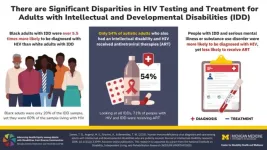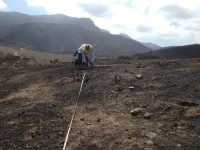(Press-News.org) Trace metals are nutrient elements, like zinc, that animals and plants need in small amounts to function properly. Animals generally get trace metals in their diets or through environmental exposures, while plants take their trace minerals up from soil. If we get too little, we may experience a deficiency, but the opposite can also be true: too much of a trace metal can be toxic.
Scientists believe that up to 50% of the trace metals in soils and urban environments may be bound to the surfaces of mineral grains — rendering the trace metals essentially unavailable for consumption or exposure. Researchers at Washington University in St. Louis wondered what holds them in place.
“When minerals bind trace metals, we often assume that they act like a sponge,” said Jeffrey G. Catalano, a professor of earth, environmental and planetary sciences and the director of environmental studies in Arts & Sciences. “But sometimes, they bind trace metals and won’t let them go. That is great when they are contaminants, but bad when they are serving as micronutrients.”
In a study published in the journal Environmental Science & Technology, Catalano and Greg Ledingham, a PhD candidate in his laboratory, discovered that a common mineral called goethite — an iron-rich mineral that is abundant in soils that cover the Earth — tends to incorporate trace metals into its structure over time, binding the metals in such a way that it locks them out of circulation.
The portion of the trace metals that get bound to goethite scaled with ion size, the researchers found. Up to 70% of nickel, the trace metal with the smallest ionic radii in this study, was non-recoverable, while only 8% of cadmium was irreversibly bound to goethite.
“In the past, to study how trace metals attach and are retained at mineral surfaces, geochemists had to substantially alter the chemical conditions in ways that were not realistic or true to real-world systems,” said Ledingham, who is a graduate fellow of the McDonnell Center for the Space Sciences. “Changing the pH, for instance, affects how particles group together and can influence how metals bind to the surface.
“We used a new approach called isotope exchange that allowed us to track how metals bind, detach and incorporate into iron oxyhydroxides in real time and in conditions representative of real soils and river systems,” he said.
“Our study suggests that iron oxyhydroxide minerals, like goethite, may be a much better sink for trace metals than previously thought,” Catalano said.
Knowing that goethite tends to naturally trap trace metals over time could help scientists to better predict how certain contaminants move through the environment, study authors said. It also could mean that trace metal nutrients added to farm and garden soils may become less effective after a few months.
The findings suggest the environmental impact is mixed: trapping metals acting as contaminants will clean up soils and water supplies, but metals serving as essential nutrients are also unavailable for plants and other organisms, the researchers said.
Greg J. Ledingham, Yihang Fang, and Jeffrey G. Catalano. Irreversible Trace Metal Binding to Goethite Controlled by the Ion Size. Environmental Science & Technology 2024 58 (4), 2007-2016. DOI: 10.1021/acs.est.3c06516
This research is funded in part by the National Science Foundation.
END
The ties that bind
A common mineral in red soils tends to lock away trace metals over time, according to WashU research
2024-02-15
ELSE PRESS RELEASES FROM THIS DATE:
New GSA publication addresses dementia care in adults with I/DD
2024-02-15
Addressing Brain Health in Adults With Intellectual Disabilities and Developmental Disabilities: A Companion to the KAER Toolkit for Primary Care Providers is a new publication from the Gerontological Society of America (GSA) designed to address the needs of adults with intellectual and developmental disabilities (I/DD) who develop dementia.
Freely available at geron.org/brainhealth, this companion document:
Raises awareness of unique needs of adults living with I/DD.
Equips and encourages caregivers and health care teams to engage in ...
Inequities in HIV testing, diagnosis and care for people with intellectual and developmental disabilities
2024-02-15
People with disabilities are often at higher risk for exposure to HIV due to barriers in engaging healthcare and other systemic factors and are thus considered a priority for prevention and testing efforts. However, these efforts don’t always extend to people with intellectual disabilities due to the perception that people with intellectual disabilities are mostly asexual.
Researchers at University of Michigan Health conducted one of the largest epidemiological studies of individuals with intellectual and developmental disabilities to closely examine where the gaps in HIV care lie and found large disparities in care for Black patients as well as for patients ...
Earthquake fatality measure offers new way to estimate impact on countries
2024-02-15
A new measure that compares earthquake-related fatalities to a country’s population size concludes that Ecuador, Lebanon, Haiti, Turkmenistan, Iran and Portugal have experienced the greatest impact from fatalities in the past five centuries.
The new impact measure, introduced in the Bulletin of the Seismological Society of America by Max Wyss and colleagues at International Centre for Earth Simulation Foundation, is called the earthquake fatality load or EQFL. The EQFL of a particular earthquake is the ratio of earthquake fatalities to the population estimate for the country in the year of the earthquake.
In their study, Wyss, Michel Speiser ...
Using cannabis can ease cravings for street-level drugs, UBC research suggests
2024-02-15
New findings from researchers at the University of British Columbia suggest that cannabis could play a role in addressing the ongoing opioid overdose crisis.
A new publication from Dr. Hudson Reddon, alongside UBC Okanagan’s Dr. Zach Walsh and UBC Vancouver’s Dr. M-J Milloy, observed that using cannabis is associated with decreased use of crystal methamphetamine among people at highest risk of overdose in Vancouver’s Downtown Eastside.
About 45 per cent of the study’s participants reported using cannabis to manage their cravings for stimulant drugs ...
New nuclei can help shape our understanding of fundamental science on Earth and in the cosmos
2024-02-15
EAST LANSING, Mich. – In creating five new isotopes, an international research team working at the Facility for Rare Isotope Beams, or FRIB, at Michigan State University has brought the stars closer to Earth.
The isotopes — known as thulium-182, thulium-183, ytterbium-186, ytterbium-187 and lutetium-190 — were reported Feb. 15 in the journal Physical Review Letters.
These represent the first batch of new isotopes made at FRIB, a user facility for the U.S. Department of Energy ...
Searching for clues in the history book of the ocean
2024-02-15
Oxygen is fundamental to sustaining life on Earth. The ocean gets its oxygen from its uppermost layers in contact with the atmosphere. As our planet continues to warm, the ocean is gradually losing its capacity to absorb oxygen, with severe consequences on marine ecosystems and human activities that depend on them. While these trends will likely continue in the future, it remains unclear how ocean oxygen will redistribute across the ocean interior, where ocean currents and biological degradation of biomass dominate over atmospheric diffusion.
“Marine sediments are the history book of the ocean. ...
Car fumes, weeds pose double whammy for fire-loving native plants
2024-02-15
Springtime brings native wildflowers to bloom in the Santa Monica Mountains, northwest of Los Angeles. These beauties provide food for insects, maintain healthy soil and filter water seeping into the ground — in addition to offering breathtaking displays of color.
They’re also good at surviving after wildfire, having adapted to it through millennia. But new research shows wildflowers that usually would burst back after a blaze and a good rain are losing out to the long-standing, double threat of city smog and nonnative weeds.
A recent study led by Justin Valliere, assistant professor in the UC ...
How Chinese migrants in Los Angeles Chinatown gained self-reliance
2024-02-15
In the late 1800s and early 1900s, anti-Chinese sentiment in the United States was high, as working-class laborers in the country viewed Chinese workers as a threat.
Prior research has found that during that period, approximately 400,000 Chinese migrants came to the U.S., many of whom went to California to build the Transcontinental Railroad. Following the project's completion, competition for jobs grew tougher, and passage of the Chinese Exclusion Act in 1882 banned Chinese laborers from immigrating to the U.S.
But ...
New study by researchers at UNC-Chapel Hill finds chemical composition of US air pollution changed over time
2024-02-15
A new study published in Atmospheric Environment by researchers at the University of North Carolina at Chapel Hill analyzed space and time trends for fine particulate matter (PM2.5) in the continental United States to track the progress of regulatory actions by federal, state and local authorities aimed at curbing air pollution. The team found that while the annual average concentration for PM2.5 had been significantly reduced, its chemical composition had changed during the study period of 2006 to 2020. Their analysis suggests targeted strategies to reduce specific pollutants for different regions ...
ASHG names Amanda Perl as Chief Executive Officer
2024-02-15
For Immediate Release: Thursday, February 15, 2024, 3:00pm U.S. Eastern Time
Media Contact: Kara Flynn, 202.257.8424, press@ashg.org
ROCKVILLE, MD - The American Society of Human Genetics (ASHG) is excited to announce the selection of Amanda Perl as the organization’s next Chief Executive Officer. Perl has served in numerous association leadership positions with deep experience in strategic planning, membership, publishing, communications, and society operations, as well as meetings and conferences.
“ASHG is delighted to welcome Amanda, a seasoned association executive, to the team,” said ASHG President Bruce D. Gelb, MD. “We are confident ...
LAST 30 PRESS RELEASES:
Making lighter work of calculating fluid and heat flow
Normalizing blood sugar can halve heart attack risk
Lowering blood sugar cuts heart attack risk in people with prediabetes
Study links genetic variants to risk of blinding eye disease in premature infants
Non-opioid ‘pain sponge’ therapy halts cartilage degeneration and relieves chronic pain
AI can pick up cultural values by mimicking how kids learn
China’s ecological redlines offer fast track to 30 x 30 global conservation goal
Invisible indoor threats: emerging household contaminants and their growing risks to human health
Adding antibody treatment to chemo boosts outcomes for children with rare cancer
Germline pathogenic variants among women without a history of breast cancer
Tanning beds triple melanoma risk, potentially causing broad DNA damage
Unique bond identified as key to viral infection speed
Indoor tanning makes youthful skin much older on a genetic level
Mouse model sheds new light on the causes and potential solutions to human GI problems linked to muscular dystrophy
The Journal of Nuclear Medicine ahead-of-print tip sheet: December 12, 2025
Smarter tools for peering into the microscopic world
Applications open for funding to conduct research in the Kinsey Institute archives
Global measure underestimates the severity of food insecurity
Child survivors of critical illness are missing out on timely follow up care
Risk-based vs annual breast cancer screening / the WISDOM randomized clinical trial
University of Toronto launches Electric Vehicle Innovation Ontario to accelerate advanced EV technologies and build Canada’s innovation advantage
Early relapse predicts poor outcomes in aggressive blood cancer
American College of Lifestyle Medicine applauds two CMS models aligned with lifestyle medicine practice and reimbursement
Clinical trial finds cannabis use not a barrier to quitting nicotine vaping
Supplemental nutrition assistance program policies and food insecurity
Switching immune cells to “night mode” could limit damage after a heart attack, study suggests
URI-based Global RIghts Project report spotlights continued troubling trends in worldwide inhumane treatment
Neutrophils are less aggressive at night, explaining why nighttime heart attacks cause less damage than daytime events
Menopausal hormone therapy may not pose breast cancer risk for women with BRCA mutations
Mobile health tool may improve quality of life for adolescent and young adult breast cancer survivors
[Press-News.org] The ties that bindA common mineral in red soils tends to lock away trace metals over time, according to WashU research


